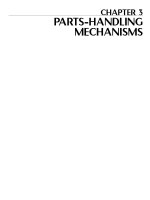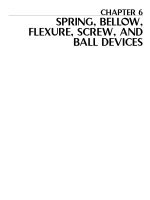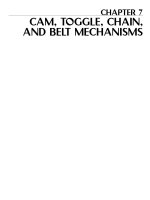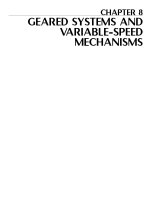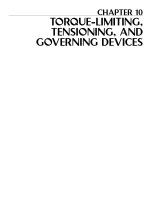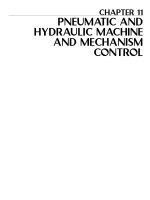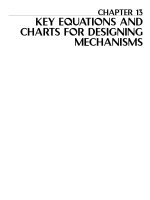Mechanisms and Mechanical Devices Sourcebook - Chapter 13
Bạn đang xem bản rút gọn của tài liệu. Xem và tải ngay bản đầy đủ của tài liệu tại đây (1.54 MB, 33 trang )
CHAPTER 13
KEY EQUATIONS AND
CHARTS FOR DESIGNING
MECHANISMS
Sclater Chapter 13 5/3/01 1:31 PM Page 429
430
FOUR-BAR LINKAGES AND
TYPICAL INDUSTRIAL APPLICATIONS
All mechanisms can be broken down into equivalent four-bar linkages. They can be considered
to be the basic mechanism and are useful in many mechanical operations.
FOUR-BAR LINKAGES—Two cranks, a
connecting rod and a line between the fixed
centers of the cranks make up the basic
four-bar linkage. Cranks can rotate if A is
smaller than B or C or D. Link motion can
be predicted.
FOUR-BAR LINK WITH SLIDING MEMBER—
One crank is replaced by a circular slot with an
effective crank distance of B.
PARALLEL CRANK—Steam control linkage
assures equal valve openings.
SLOW MOTION LINK—As crank A is
rotated upward it imparts motion to crank B.
When A reaches its dead center position,
the angular velocity of crank
B decreases to
zero.
TRAPAZOIDAL LINKAGE—This linkage is
not used for complete rotation but can be
used for special control. The inside moves
through a larger angle than the outside with
normals intersecting on the extension of a
rear axle in a car.
CRANK AND ROCKER—the following
relations must hold for its operation:
A + B +C > D; A + D + B > C;
A + C – B < D, and C – A + B > D.
NON-PARALLEL EQUAL CRANK—The
centrodes are formed as gears for passing
dead center and they can replace ellipticals.
DOUBLE PARALLEL CRANK MECHA-
NISM—This mechanism forms the basis for
the universal drafting machine.
ISOSCELES DRAG LINKS—This “lazy-tong”
device is made of several isosceles links; it is
used as a movable lamp support.
WATT’S STRAIGHT-LINE MECHANISM—
Point T describes a line perpendicular to the
parallel position of the cranks.
PARALLEL CRANK FOUR-BAR—Both
cranks of the parallel crank four-bar linkage
always turn at the same angular speed, but
they have two positions where the crank can-
not be effective.
DOUBLE PARALLEL CRANK—This mecha-
nism avoids a dead center position by having
two sets of cranks at 90° advancement. The
connecting rods are always parallel.
Sclater Chapter 13 5/3/01 1:31 PM Page 430
431
STRAIGHT SLIDING LINK—This is the
form in which a slide is usually used to
replace a link. The line of centers and the
crank B are both of infinite length.
DRAG LINK—This linkage is used as the
drive for slotter machines. For complete
rotation: B > A + D – C and B < D + C – A.
ROTATING CRANK MECHANISM—This
linkage is frequently used to change a
rotary motion to a swinging movement.
NON-PARALLEL EQUAL CRANK—If crank
A has a uniform angular speed, B will vary.
ELLIPTICAL GEARS—They produce the
same motion as non-parallel equal cranks.
NON-PARALLEL EQUAL CRANK—It is the
same as the first example given but with
crossover points on its link ends.
TREADLE DRIVE—This four-bar linkage is
used in driving grinding wheels and sewing
machines.
DOUBLE LEVER MECHANISM—This
slewing crane can move a load in a hori-
zontal direction by using the D-shaped por-
tion of the top curve.
PANTOGRAPH—The pantograph is a par-
allelogram in which lines through
F, G and
H must always intersect at a common point.
ROBERT’S STRAIGHT-LINE MECHA-
NISM—The lengths of cranks
A and B
should not be less than 0.6 D; C is one half
of
D.
TCHEBICHEFF’S—Links are made in pro-
portion:
AB = CD = 20, AD = 16, BC = 8.
PEAUCELLIER’S CELL—When propor-
tioned as shown, the tracing point T forms a
straight line perpendicular to the axis.
Sclater Chapter 13 5/3/01 1:31 PM Page 431
432
DESIGNING GEARED FIVE-BAR MECHANISMS
Geared five-bar mechanisms offer excellent force-transmission characteristics and can produce
more complex output motions—including dwells—than conventional four-bar mechanisms.
It is often necessary to design a mecha-
nism that will convert uniform input
rotational motion into nonuniform output
rotation or reciprocation. Mechanisms
designed for such purposes are usually
based on four-bar linkages. Those link-
ages produce a sinusoidal output that can
be modified to yield a variety of motions.
Four-bar linkages have their limita-
tions, however. Because they cannot pro-
duce dwells of useful duration, the
designer might have to include a cam
when a dwell is desired, and he might
have to accept the inherent speed restric-
tions and vibration associated with cams.
A further limitation of four-bar linkages
is that only a few kinds have efficient
force-transmission capabilities.
One way to increase the variety of
output motions of a four-bar linkage, and
obtain longer dwells and better force
transmissions, is to add a link. The result-
ing five-bar linkage would become
impractical, however, because it would
then have only two degrees of freedom
and would, consequently, require two
inputs to control the output.
Simply constraining two adjacent
links would not solve the problem. The
five-bar chain would then function effec-
tively only as a four-bar linkage. If, on
the other hand, any two nonadjacent
links are constrained so as to remove
only one degree of freedom, the five-bar
chain becomes a functionally useful
mechanism.
Gearing provides solution. There are
several ways to constrain two non-
adjacent links in a five-bar chain. Some
possibilities include the use of gears,
slot-and-pin joints, or nonlinear band
mechanisms. Of these three possibilities,
gearing is the most attractive. Some prac-
tical gearing systems (Fig. 1) included
paired external gears, planet gears
revolving within an external ring gear,
and planet gears driving slotted cranks.
In one successful system (Fig. 1A)
each of the two external gears has a fixed
crank that is connected to a crossbar by a
rod. The system has been successful in
high-speed machines where it transforms
rotary motion into high-impact linear
motion. The Stirling engine includes a
similar system (Fig. 1B).
In a different system (Fig. 1C) a pin
on a planet gear traces an epicyclic,
three-lobe curve to drive an output crank
back and forth with a long dwell at the
Fig. 1 Five-bar mechanism designs can be based on paired external gears or planetary
gears. They convert simple input motions into complex outputs.
Sclater Chapter 13 5/3/01 1:31 PM Page 432
extreme right-hand position. A slotted
output crank (Fig. 1D) will provide a
similar output.
Two professors of mechanical engi-
neering, Daniel H. Suchora of Youngstown
State University, Youngstown, Ohio, and
Michael Savage of the University of
Akron, Akron, Ohio, studied a variation of
this mechanism in detail.
Five kinematic inversions of this form
(Fig. 2) were established by the two
researchers. As an aid in distinguishing
between the five, each type is named
according to the link which acts as the
fixed link. The study showed that the
Type 5 mechanism would have the great-
est practical value.
In the Type 5 mechanism (Fig. 3A),
the gear that is stationary acts as a sun
gear. The input shaft at Point E drives the
input crank which, in turn, causes the
planet gear to revolve around the sun
gear. Link
a
2
, fixed to the planet, then
drives the output crank, Link
a
4
, by
means of the connecting link, Link
a
3
. At
any input position, the third and fourth
links can be assembled in either of two
distinct positions or “phases” (Fig. 3B).
Variety of outputs. The different kinds
of output motions that can be obtained
from a Type 5 mechanism are based on
the different epicyclic curves traced by
link joint B. The variables that control the
shape of a “B-curve” are the gear ratio
GR (GR = N
2
/N
5
), the link ratio a
2
/a
1
and
the initial position of the gear set,
defined by the initial positions of
θ
1
and
θ
2
, designated as
θ
10
and
θ
20
, respectively.
Typical B-curve shapes (Fig. 4)
include ovals, cusps, and loops. When
the B-curve is oval (Fig. 4B) or semioval
(Fig. 4C), the resulting B-curve is similar
to the true-circle B-curve produced by a
four-bar linkage. The resulting output
motion of Link
a
4
will be a sinusoidal
type of oscillation, similar to that pro-
duced by a four-bar linkage.
When the B-curve is cusped (Fig.
4A), dwells are obtained. When the B-
curve is looped (Figs. 4D and 4E), a dou-
ble oscillation is obtained.
In the case of the cusped B-curve
(Fig. 4A), dwells are obtained. When the
B-curve is looped (Figs. 4D and 4E), a
double oscillation is obtained.
In the case of the cusped B-curve
(Fig. 4A), by selecting
a
2
to be equal to
the pitch radius of the planet gear
r
2
, link
joint B becomes located at the pitch cir-
cle of the planet gear. The gear ratio in all
the cases illustrated is unity (
GR = 1).
Professors Suchora and Savage ana-
lyzed the different output motions pro-
duced by the geared five-bar mecha-
nisms by plotting the angular position
θ
4
of the output link a
4
of the output link a
4
against the angular position of the input
link
θ
1
for a variety of mechanism con-
figurations (Fig. 5).
433
Fig. 2 Five types of geared five-bar mechanisms. A different link acts as the fixed link in
each example. Type 5 might be the most useful for machine design.
Fig. 3 A detailed design of a Type-5 mechanism. The input crank causes the planet gear to
revolve around the sun gear, which is always stationary.
Sclater Chapter 13 5/3/01 1:32 PM Page 433
434
Designing Geared Five-Bar Mechanisms (continued )
Fig. 4 Typical B-curve shapes obtained from various Type-5 geared five-bar mechanisms. The
shape of the epicyclic curved is changed by the link ratio a
2
/a
1
and other parameters, as described in
the text.
Sclater Chapter 13 5/3/01 1:32 PM Page 434
In three of the four cases illustrated,
GR = 1, although the gear pairs are not
shown. Thus, one input rotation gener-
ates the entire path of the B-curve. Each
mechanism configuration produces a dif-
ferent output.
One configuration (Fig. 5A) produces
an approximately sinusoidal reciprocat-
ing output motion that typically has bet-
ter force-transmission capabilities than
equivalent four-bar outputs. The trans-
mission angle
µ should be within 45 to
135º during the entire rotation for best
results.
Another configuration (Fig. 5B) pro-
duces a horizontal or almost-horizontal
portion of the output curve. The output
link, link,
a
4
, is virtually stationary dur-
ing this period of input rotation—from
about 150 to 200º of input rotation
θ
1
in
the case illustrated. Dwells of longer
duration can be designed.
By changing the gear ratio to 0.5 (Fig.
5C), a complex motion is obtained; two
intermediate dwells occur at cusps 1 and
2 in the path of the B-curve. One dwell,
from
θ
1
= 80 to 110º, is of good quality.
The dwell from 240 to 330º is actually a
small oscillation.
Dwell quality is affected by the loca-
tion of Point D with respect to the cusp,
and by the lengths of links
a
3
and a
4
. It is
possible to design this form of mecha-
nism so it will produce two usable dwells
per rotation of input.
In a double-crank version of the
geared five-bar mechanism (Fig. 5D), the
output link makes full rotations. The out-
put motion is approximately linear, with
a usable intermediate dwell caused by
the cusp in the path of the B-curve.
From this discussion, it’s apparent
that the Type 5 geared mechanism with
GR = 1 offers many useful motions for
machine designers. Professors Suchora
and Savage have derived the necessary
displacement, velocity, and acceleration
equations (see the “Calculating displace-
ment, velocity, and acceleration” box).
435
Fig. 5 A variety of output motions can be produced by varying the design of five-bar
geared mechanisms. Dwells are obtainable with proper design. Force transmission is excel-
lent. In these diagrams, the angular position of the output link is plotted against the angular
position of the input link for various five-bar mechanism designs.
Sclater Chapter 13 5/3/01 1:32 PM Page 435
KINEMATICS OF INTERMITTENT MECHANISMS—
THE EXTERNAL GENEVA WHEEL
436
One of the most commonly applied
mechanisms for producing intermittent
rotary motion from a uniform input
speed is the external geneva wheel.
The driven member, or star wheel,
contains many slots into which the roller
of the driving crank fits. The number of
slots determines the ratio between dwell
and motion period of the driven shaft.
The lowest possible number of slots is
three, while the highest number is theo-
retically unlimited. In practice, the three-
slot geneva is seldom used because of the
extremely high acceleration values
encountered. Genevas with more than 18
slots are also infrequently used because
they require wheels with comparatively
large diameters.
In external genevas of any number of
slots, the dwell period always exceeds
the motion period. The opposite is true of
the internal geneva. However, for the
spherical geneva, both dwell and motion
periods are 180º.
For the proper operation of the exter-
nal geneva, the roller must enter the slot
tangentially. In other words, the center-
line of the slot and the line connecting
the roller center and crank rotation center
must form a right angle when the roller
enters or leaves the slot.
The calculations given here are based
on the conditions stated here.
Fig. 1 A basic outline drawing for the external geneva wheel. The
symbols are identified for application in the basic equations.
Fig. 2 A schematic drawing of a six-slot geneva wheel. Roller
diameter, d
r
, must be considered when determining D.
Sclater Chapter 13 5/3/01 1:32 PM Page 436
Consider an external geneva wheel,
shown in Fig. 1, in which
n = number of slots
a = crank radius
From
Fig. 1,
b = center distance =
Let
Then
b = am
It will simplify the development of
the equations of motion to designate the
connecting line of the wheel and crank
centers as the zero line. This is contrary
to the practice of assigning the zero value
of
α
, representing the angular position of
the driving crank, to that position of the
crank where the roller enters the slot.
Thus, from Fig. 1, the driven crank
radius
f at any angle is:
(1)
fama
mm
=− +
=+−
( cos ) sin
cos
αα α
αα
222
2
12
1
180
sin
n
m=
a
n
sin
180
437
Fig. 3 A four-slot geneva (A) and an
eight-slot geneva (B). Both have locking
devices.
Fig. 5 Chart for determining the angular velocity of the driven member.
Fig. 4 Chart for determining the angular displacement of the driven member.
Sclater Chapter 13 5/3/01 1:32 PM Page 437
Kinematics of Intermittent Mechanisms (continued )
and the angular displacement β can be
found from:
(2)
A six-slot geneva is shown schemati-
cally in Fig. 2. The outside diameter
D of
the wheel (when accounting for the effect
of the roller diameter
d) is found to be:
(3)
Differentiating Eq. (2) and dividing
by the differential of time, dt, the angular
velocity of the driven member is:
(4)
where ω represents the constant angular
velocity of the crank.
By differentiation of Eq. (4) the accel-
eration of the driven member is found to
be:
(5)
All notations and principal formulas
are given in Table I for easy reference.
Table II contains all the data of principal
interest for external geneva wheels having
from 3 to 18 slots. All other data can be
read from the charts: Fig. 4 for angular
position, Fig. 5 for angular velocity, and
Fig. 6 for angular acceleration.
d
dt
mm
mm
2
2
2
2
22
1
12
β
ω
α
α
=
−
+−
sin ( )
( cos )
d
dt
m
mm
βα
α
=
−
+−
ω
cos
cos
1
12
2
D
d
a
n
r
=+2
4
180
2
22
cot
cos
cos
cos
β
α
=
−
+−
ma
mm12
2
Fig. 6 Chart for determining the angular acceleration of the driven member.
438
Sclater Chapter 13 5/3/01 1:32 PM Page 438
KINEMATICS OF INTERMITTENT MECHANISMS—
THE INTERNAL GENEVA WHEEL
Where intermittent drives must provide
dwell periods of more than 180º, the
external geneva wheel design is satisfac-
tory and is generally the standard device
employed. But where the dwell period
must be less than 180º, other intermittent
drive mechanisms must be used. The
internal geneva wheel is one way of
obtaining this kind of motion.
The dwell period of all internal
genevas is always smaller than 180º.
Thus, more time is left for the star wheel
to reach maximum velocity, and acceler-
ation is lower. The highest value of angu-
lar acceleration occurs when the roller
enters or leaves the slot. However, the
acceleration occurs when the roller
enters or leaves the slot. However, the
acceleration curve does not reach a peak
within the range of motion of the driven
wheel. The geometrical maximum would
occur in the continuation of the curve.
But this continuation has no significance
because the driven member will have
entered the dwell phase associated with
the high angular displacement of the
driving member.
The geometrical maximum lies in the
continuation of the curve, falling into the
region representing the motion of the
external geneva wheel. This can be seen
by the following considerations of a
crank and slot drive, drawn in Fig. 2.
When the roller crank
R rotates, slot
link
S will perform an oscillating move-
Fig. 1 A four-slot internal geneva wheel incorporating a locking
mechanism. The basic sketch is shown in Fig. 3.
Fig. 2 Slot-crank motion from A to B represents external geneva
action; from B to A represents internal geneva motion.
439
Sclater Chapter 13 5/3/01 1:32 PM Page 439
ment, for which the displacement, angu-
lar velocity, and acceleration can be
given in continuous curves.
When the crank
R rotates from A to B,
then the slot link
S will move from C to
D, exactly reproducing all moving condi-
tions of an external geneva of equal slot
angle. When crank
R continues its move-
ment from
B back to A, then the slot link
S will move from D back to C, this time
reproducing exactly (though in a mirror
picture with the direction of motion
being reversed) the moving conditions of
an internal geneva.
Therefore, the characteristic curves of
this motion contain both the external and
internal geneva wheel conditions; the
region of the external geneva lies
between
A and B, the region of the inter-
nal geneva lies between
B and A.
The geometrical maxima of the accel-
eration curves lie only in the region
between
A and B, representing that por-
tion of the curves which belongs to the
external geneva.
The principal advantage of the internal
geneva, other than its smooth operation, is
it sharply defined dwell period. A disad-
vantage is the relatively large size of the
driven member, which increases the force
resisting acceleration. Another feature,
which is sometimes a disadvantage, is the
cantilever arrangement of the roller crank
shaft. This shaft cannot be a through shaft
because the crank must be fastened to the
overhanging end of the input shaft.
To simplify the equations, the con-
necting line of the wheel and crank cen-
ters is taken as the zero line. The angular
440
Kinematics of Intermittent Mechanisms (continued )
Fig. 3 A basic outline for developing the equations of the internal
geneva wheel, based on the notations shown.
Fig. 4 A drawing of a six-slot internal geneva wheel. The sym-
bols are identified, and the motion equations are given in Table I.
Fig. 5 Angular displacement of the driven member can be determined from this chart.
Sclater Chapter 13 5/3/01 1:32 PM Page 440
position of the driving crank α is zero
when it is on this line. Then the follow-
ing relations are developed, based on
Fig. 3.
n = number of slots
a = crank radius
b = center distance =
Let
then;
b = am
To find the angular displacement
β
of
the driven member, the driven crank
radius
f is first calculated from:
(1)
and because
it follows:
(2)
From this formula,
β
, the angular dis-
placement, can be calculated for any
angle
α
, the angle of the mechanism’s
driving member.
The first derivative of Eq. (2) gives
the angular velocity as:
(3)
where
ω
designates the uniform speed of
the driving crank shaft, namely:
if
p equals its number of revolutions per
minute.
Differentiating Eq. (3) once more
develops the equation for the angular
acceleration:
(4)
The maximum angular velocity
occurs, obviously, at
α
= 0º. Its value is
found by substituting 0º for
α in Eq. (3).
It is:
(5)
d
dt m
βω
max
=
+1
d
dt
mm
mm
2
2
2
2
22
1
12
β
ω
α
α
=
−
++
sin ( )
( cos )
ω
π
=
p
30
d
dt
m
mm
β
ω
α
α
=
+
++
1
12
2
cos
cos
cos
cos
cos
β
α
α
=
+
++
m
mm12
2
cos
cos
β
α
=
+m
f
f a am a
mm
=++
=++
22 2
2
12
sin ( cos )
cos
αα
αα
1
180
sin
º
,
n
m=
a
n
sin
º180
441
Fig. 6 Angular velocity of the driven member can be determined from this chart.
Fig. 7 Angular acceleration of the driven member can be determined from this chart.
Sclater Chapter 13 5/3/01 1:32 PM Page 441
